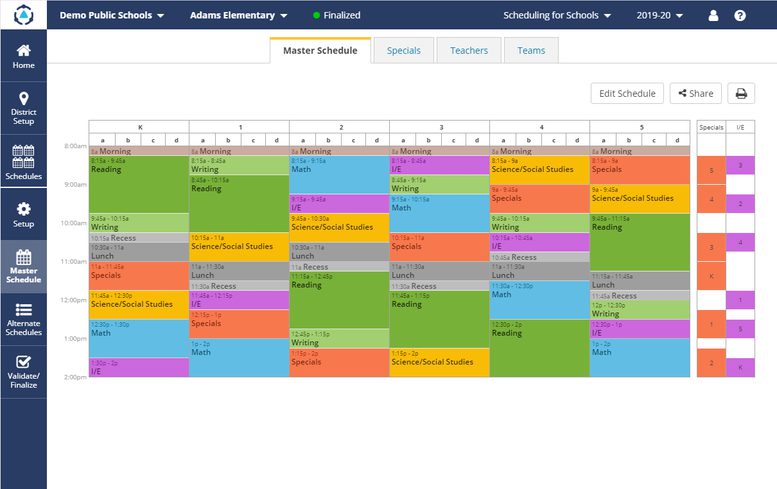This 12-part How to Build an Elementary School Schedule series shares expert step-by-step guidance and proven scheduling strategies to help you create better schedules this year.
By now, you’ve worked through the most critical items on your schedule. You’ve scheduled specials efficiently, managed constraints when scheduling lunch and recess, strategically scheduled English language arts and math, and scheduled a daily intervention/enrichment period to help each student get what they need.
While you aren’t done yet, you’re off to a great start. You’ll want to make sure you don’t undo all of the great learning opportunities you’ve already created when you schedule remaining periods. Here are a few things to consider as you schedule the balance of the school day:
- Science and Social Studies
- Will pull out services be allowed during social studies or science time?
- How will that influence scheduling of these subjects across grades (e.g. staggered)?
- Can this time be targeted for lower frequency and duration services (e.g. 1x/week for 15 minutes) to maximize time in class?
- Morning Meeting and Dismissal
- Is there a homeroom period or morning meeting?
- Does your morning meeting include instruction (e.g. SEL)?
- How long should morning meetings be?
- Do all teachers of a grade utilize this time in the same manner?
- How does this time impact a student’s well-being or academics?
- How much time is needed for students to pack their bags and prepare for dismissal?
- Should more time be allotted for younger students?
- Are all classrooms allocating the same amount of time for these activities?
- Transitions
- Many schools include transition time in the instructional time. This translates to the first and/or last few minutes of each subject serving as transition time. This might be two minutes for in-class transitions (e.g. switch from ELA to Social Studies) or 2-4 minutes for out-of-classroom transitions (e.g. walk to specials, lunch or recess).
- Some schools explicitly schedule transition times when students leave their classrooms (e.g. specials, lunch, and recess). Consider the physical layout and size of your school and reasonable travel times to and from various rooms. What is the range of transition time needed? When possible, establish a consistent transition time across a grade. Consistent transition time will help foster equal access to subject instructional minutes across the day.
- Other Subjects (i.e. Language)
Science and social studies are important subjects that can help to reinforce core lessons but are often the last subjects scheduled. Understanding how these subjects will be leveraged with your ELA and math curriculum can impact your scheduling decisions.
In lower elementary grades, these subjects often are delivered in a common period (i.e. Science/Social Studies), while in upper elementary grades, these subjects are typically independent periods. Where to place these combination or independent subject periods should be driven by your curriculum. If you integrate reading and writing skills into your social studies curriculum, you may want social studies to follow your ELA period. The same may be true for science if it is integrated with math. In other cases, schools may want to create more separation between these subjects so related lessons can occur throughout the day versus concentrated into large blocks of time.
Be sure to also consider students receiving a higher number of support services throughout the day and think about how these students might receive more science and social studies instruction. For example:
Do you schedule morning meetings, dismissal, or other homeroom periods? These periods can be helpful when scheduled strategically but can also be a source of time vacuums that shorten the school day.
One common practice is more time for the youngest students to begin and end their school day. For example, students in grades PK-1 have not developed their arrival and dismissal routines like the older students. This extra time for younger students is typically 5-10 minutes before the first period and after the last period. How much time is allotted in your school?
Starting the day off right is important. Some schools jump right into the first subject, whereas others may have structured or unstructured morning routines. The following questions will help you understand your morning routines while exploring the impact of this time for students. What will the beginning of each school day look like for your school?
Dismissal routines can be chaotic. Students are packing and lining up for buses, parent pick up, or after school activities. What is your plan to manage this end of day routine?
Reviewing and understanding the use of these periods can be insightful and help you embrace efforts that are helping students and/or help you find those precious minutes impacting the instructional day.
Time spent on transitions can add up quickly! Multiply the number of daily transitions by the minutes allocated to each transition. Is the total more than you thought? It is important to have a strategy for managing transitions and to communicate this strategy to all staff. Consider these different approaches:
If you have language immersion, ELL, or other more intensive programs, consider these in conjunction with your core curriculum. These programs commonly mirror core instructional blocks and have broader implications.

About DMSchedules
Create Better School and Staff Schedules Now with DMGroup’s DMSchedules Scheduling Software
Learn moreElementary Scheduling Software

